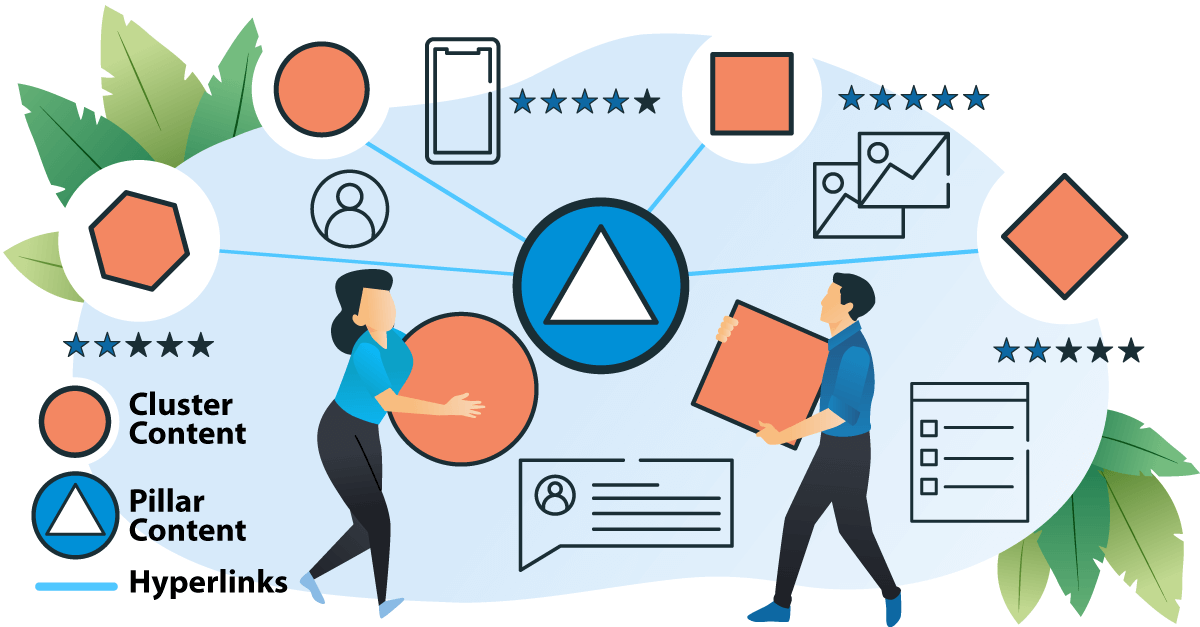
Unlocking the Power of SEO: Maximizing Impact with Content Clusters
In the ever-evolving landscape of digital marketing, maximizing SEO impact with content clusters has emerged as a powerful strategy for enhancing online visibility and driving traffic to websites. By strategically organizing related content around a central topic or keyword, businesses can unlock the full potential of their SEO efforts. In this guide, we delve into the concept of content clusters and explore how they can be leveraged to optimize search engine rankings, attract targeted audiences, and ultimately maximize the impact of an organization’s online presence.
Search Engine Optimization (SEO) is the process of improving your website’s visibility on search engines like Google. By optimizing your website for relevant keywords and creating high-quality content, you can increase your chances of ranking higher in search results. Keywords are the words or phrases that users type into search engines when looking for information. By incorporating these keywords strategically into your website content, you can attract more organic traffic.
In simple terms, SEO is about making your website easier for search engines to understand and rank. This involves optimizing your website structure, content, and backlinks to show search engines that your website is relevant and valuable to users. By following SEO best practices and staying up to date with algorithm changes, you can improve your website’s visibility and attract more visitors. Remember, SEO is a long-term strategy that requires consistent effort and monitoring to see results.
Keyword research is a crucial component of content clusters, as it helps to identify the specific keywords and phrases that your target audience is searching for. By conducting thorough keyword research, you can better understand the language and terms that your audience uses, allowing you to create content that aligns with their needs and interests. This helps to optimize your content for search engines, making it more likely to appear in relevant search results and attract organic traffic.
In simple terms, keyword research acts as a roadmap for creating content that resonates with your audience and improves your website’s visibility in search engine results. By incorporating strategically chosen keywords into your content clusters, you can increase the likelihood of ranking higher in search engine rankings and driving more traffic to your website. This ultimately leads to better engagement with your target audience and increased opportunities for conversion and growth. Therefore, investing time and effort into keyword research is essential for maximizing the impact of your content clusters and unlocking their full potential in driving organic traffic to your website.
In order to create a successful SEO strategy, it is crucial to focus on creating pillar content. Pillar content serves as the foundation of your website, providing valuable and comprehensive information on a specific topic. By creating high-quality pillar content, you can establish your website as an authority in your industry and improve your search engine rankings.
When creating pillar content, it is important to choose topics that are relevant to your target audience and align with your overall business goals. By conducting keyword research and understanding the search intent behind these keywords, you can optimize your pillar content to attract organic traffic from search engines. Additionally, incorporating internal and external links within your pillar content can help improve its visibility and credibility in the eyes of search engines.
By focusing on creating pillar content as part of your SEO strategy, you can maximize your impact online and drive more traffic to your website. Remember to regularly update and optimize your pillar content to ensure it remains relevant and valuable to your audience. Ultimately, investing time and effort into creating high-quality pillar content will help you establish a strong online presence and improve your search engine rankings over time.
Implementing internal linking for content clusters is a crucial strategy for optimizing your website’s SEO performance. By strategically connecting related content within your site through hyperlinks, you can help search engines understand the relevance and hierarchy of your pages. This not only improves the user experience by guiding visitors to more valuable information, but also boosts your site’s overall visibility and authority in search engine rankings.
When creating content clusters, it’s important to establish a strong internal linking structure that connects them seamlessly. By linking from a pillar page (comprehensive topic overview) to cluster content (in-depth articles related to the main topic) and vice versa, you signal to search engines that these pages are closely related and should be considered as a unified entity. This interlinking strategy helps distribute link equity throughout your site, reinforcing the importance of your target keywords and boosting the overall SEO value of your content clusters. Remember to use meaningful anchor text that accurately describes the linked content, as this can further enhance the context and relevance of your internal links for both users and search engines alike.
To boost your website’s search engine optimization (SEO) performance, optimizing meta tags and headings is crucial. Meta tags, such as meta titles and descriptions, provide search engines with concise information about your page’s content. By incorporating relevant keywords in your meta tags, you can signal to search engines what your page is about, increasing its visibility to potential visitors. Additionally, using clear and compelling headings throughout your content helps both users and search engines understand the structure and key topics of your page.
Effective meta tag optimization involves crafting unique and descriptive titles that accurately represent the content on each page. Including targeted keywords in your meta titles can improve your page’s relevance for specific search queries. Similarly, writing concise meta descriptions that entice users to click through to your page can enhance click-through rates and overall visibility in search engine results.
When it comes to headings, using clear and hierarchical structure (e.g., H1 for main headings, H2 for subheadings) helps organize your content and make it easier for search engines to crawl and index. By incorporating relevant keywords in your headings, you can further reinforce the topic relevance of your content. Overall, optimizing meta tags and headings for SEO not only improves the visibility of your website but also enhances the user experience by providing clear signals about the content of each page.
When it comes to creating content clusters, incorporating multimedia elements can significantly boost your SEO efforts. By including videos, images, infographics, and other multimedia content within your cluster, you not only enhance the user experience but also provide search engines with more valuable information to index. This can help improve your overall search engine rankings and visibility.
Multimedia content is particularly effective in engaging users and keeping them on your site for longer periods of time. Search engines like Google take into account factors such as dwell time and bounce rate when determining the relevance and quality of a website. By offering a variety of multimedia content within your content clusters, you can increase user engagement, decrease bounce rates, and ultimately improve your SEO performance.
In simple terms, incorporating multimedia content into your content clusters can make your website more appealing to both users and search engines. By providing a rich media experience, you can attract more visitors, keep them on your site longer, and improve your chances of ranking higher in search engine results. So, don’t underestimate the power of multimedia content when it comes to maximizing the impact of your SEO efforts through content clusters.
Monitoring and analyzing SEO performance is crucial for ensuring that your website is ranking well and driving organic traffic. By regularly checking key performance indicators (KPIs) such as keyword rankings, organic traffic, and backlink profile, you can identify areas for improvement and track the success of your SEO efforts. Analyzing this data allows you to make informed decisions about content creation, website optimization, and link building strategies to maximize your online visibility.
To effectively monitor and analyze SEO performance, it is important to use tools like Google Analytics and Google Search Console to track metrics like organic traffic, bounce rate, and click-through rates. By regularly reviewing these metrics and identifying trends or patterns, you can refine your SEO strategy to better target relevant keywords and optimize your content for search engines. Additionally, staying up-to-date with algorithm changes and industry best practices can help you stay ahead of the competition and continuously improve your website’s SEO performance.
One effective way to promote content clusters is by leveraging social media platforms. Social media provides a powerful channel to reach a wider audience and drive traffic to your content. By strategically sharing your content clusters on platforms like Facebook, Twitter, and LinkedIn, you can increase visibility and engagement with your target audience.
To optimize your social media promotion for SEO, it’s important to use relevant keywords and hashtags in your posts. This will help improve the discoverability of your content clusters and attract users who are searching for related topics. Additionally, engaging with your followers through comments, likes, and shares can boost your content’s reach and improve its search engine ranking.
In simple terms, social media is a valuable tool for promoting your content clusters to a larger audience. By using targeted keywords and hashtags, as well as actively engaging with followers, you can maximize the impact of your content and drive more traffic to your website. Remember to regularly share your content clusters on social media to keep your audience engaged and interested in what you have to offer.
Optimizing your website for mobile is crucial for SEO success in today’s digital landscape. With more users accessing websites on their smartphones and tablets, search engines like Google prioritize mobile-friendly sites in their rankings. This means that if your website is not optimized for mobile, you could be missing out on valuable organic traffic.
To ensure mobile optimization for SEO success, focus on creating a responsive design that adapts to different screen sizes and devices. This will improve user experience and increase the chances of users staying on your site longer. Additionally, prioritize fast loading times for mobile users by optimizing images, reducing unnecessary code, and leveraging browser caching. By making your website easy to navigate and quick to load on mobile devices, you can improve your search engine rankings and attract more organic traffic.




